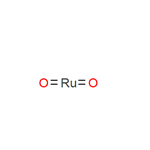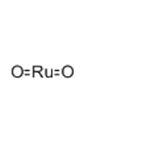- Ruthenium dioxide
-

- $0.00 / 1kg
-
2022-09-21
- CAS:12036-10-1
- Min. Order: 1kg
- Purity: 99%
- Supply Ability: 1000kg
- Ruthenium dioxide
-

- $0.00 / 1kg
-
2022-09-17
- CAS:12036-10-1
- Min. Order: 1kg
- Purity: 98%
- Supply Ability: 1Ton
- Ruthenium dioxide
-

- $0.01 / 1KG
-
2020-05-28
- CAS:12036-10-1
- Min. Order: 1KG
- Purity: 99%
- Supply Ability: 50 tons
|
| Product Name: | Ruthenium dioxide | | Synonyms: | Ruthenium(IV) oxide/ 99.9%;Ruthenium(IV) oxide,Ruthenium dioxide;RutheniuM(IV) oxide, anhydrous, 99.5+% 1GR;RutheniuM(IV) oxide 99.9% trace Metals basis;Ruthenium(IV) oxide, anhydrous, 99.95% trace metals basis;Ruthenium(IV) oxide, 99.5+%;Ruthenium(IV) oxide, anhydrous, Ru 75.2% min.;rutheniumoxide(ruo2) | | CAS: | 12036-10-1 | | MF: | O2Ru | | MW: | 133.07 | | EINECS: | 234-840-6 | | Product Categories: | Inorganics;metal oxide;chemical reaction,pharm,electronic,materials | | Mol File: | 12036-10-1.mol |  |
| | Ruthenium dioxide Chemical Properties |
| Melting point | 1200°C (subl.) | | density | 6.97 g/mL at 25 °C(lit.) | | solubility | insoluble in H2O, acid solutions | | form | Powder | | Specific Gravity | 6.97 | | color | Black | | Water Solubility | insoluble | | Sensitive | Hygroscopic | | InChIKey | WOCIAKWEIIZHES-UHFFFAOYSA-N | | CAS DataBase Reference | 12036-10-1(CAS DataBase Reference) | | EPA Substance Registry System | Ruthenium oxide (RuO2) (12036-10-1) |
| Hazard Codes | Xi | | Risk Statements | 36 | | Safety Statements | 26-36-39 | | WGK Germany | 2 | | RTECS | VM2654000 | | TSCA | Yes | | HazardClass | 5.1 | | HS Code | 28439090 |
| | Ruthenium dioxide Usage And Synthesis |
| Description | Ruthenium dioxide/ Ruthenium (IV) oxide is a black/purple solid at room temperature that is used as an electro-catalyst in chlorine oxide, chlorine and oxygen-producing reactions. Ruthenium dioxide is made of a rutile crystal structure that resembles that of titanium oxide and other closely-linked metal oxides. Its structure enhances the formation of hydrates, and it also has a great potential to store charge when applied to aqueous solutions.
| | Properties | Ruthenium (IV) oxide (RuO2) has a molecular weight of 133.068 g/mol, a monoisotopic mass of 133.894 g/mol and an exact mass of 133.894 g/mol. It also has a heavy atom count of 3 and a complexity of 18.3. The compound is hygroscopic, and it should be stored in Nitrogen, at ambient temperatures. Ruthenium dioxide is soluble in acids, water and fused alkali. It is incompatible with organic solvents, aqua regia, acids, and oxidizers.
| | Preparation | Ruthenium dioxide is prepared through various methods. The preparation methods highlighted below indicate the preparation of Ruthenium dioxide as a film.
- Through electroplating where the film is passed through a solution of RuCl3.xH2O, where a Pt gauze is applied as the electrode in the opposite direction whereas Ag/AgCl is the source electrode.
- Through chemical vapor deposition (CVD) of Ruthenium dioxide from appropriate volatile ruthenium agents.
- Through heating or pyrolysis of Ruthenium halides, preferably covering the substrate by spraying a solution of the halide on the heated substrate. The suitable halide for this method of preparation is Ruthenium (III) chloride to form Ruthenium (IV) OXIDE. This method of preparation has been developed further by scholars such as Schafer for the synthesis of partly stoichiometric Ruthenium dioxide single crystals. Nonetheless, each of the preparation procedures takes on a similar reaction mechanism:
Ru+(IV) + O2 (heat)→ RuO2
The application of bouts of high temperatures of heat (about 15000 C) can eliminate all contaminants and oxides from the reaction, and allow for the formation of a new oxide coating on the surface of Ruthenium.
| | Applications | Ruthenium dioxide is one of the primary oxygen catalysts used in a majority of chemical reactions such as the production of chlorine oxides. Ruthenium (IV) oxide is applied as an electrochemical supercapacitor agent as it has a high potential to store charge. Ruthenium dioxide is applied as a catalyst in the Deacon process where chlorine is produced through oxidation of hydrogen chloride. The high charge potential makes Ruthenium dioxide appropriate for use as an active agent in supercapacitors. The dispersion aspect of Ruthenium dioxide enhances the capacitance of nanocomposite electrode substances for supercapacitors.
Ruthenium dioxide is widely used as a doping agent, as a catalyst, and as a coating material for titanium anodes, for the elimination of hydrogen sulfide from oil refineries. Hydrogen sulfide can be divided by light in the presence of a photocatalyst-containing CdS crystals doped with Ruthenium (IV) oxide. The hydrogen obtained could be essential in the synthesis of methanol, ammonia and potentially fuel an economy driven by hydrogen.
| | Oxidative Catalyst | Ruthenium dioxide can be an ineffective catalyst in the absence of a hydrate since its surface area would decrease significantly. To obtain a pure form of the organic compound, it is annealed at about 900℃. The most efficient catalyst in electrochemical processes is accompanied by a hydrate that is not entirely a hydrous one. Ruthenium dioxide can be applied to a wide range of reactions such as fuel cells and Fischer-Tropsch process.
| | Hazard Statements | Ruthenium dioxide is a strong oxidizing agent hence it may cause explosions or fire. It may also cause acute eye irritation and when ingested, it may result in acute toxicity.
| | Chemical Properties | Dark Blue/Black Powder | | Uses | Ruthenium(IV) Oxide Anhydrous is a research reagent and applied for exfoliation of layered metal oxide nanosheets. | | Purification Methods | Free the oxide from nitrates by boiling in distilled water and filtering. A more complete purification is based on fusion in a KOH/KNO3 mix to form the soluble ruthenate and perruthenate salts. The melt is dissolved in water, and filtered, then acetone is added to reduce the ruthenates to the insoluble hydrated oxide which, after making a slurry with paper pulp, is filtered and ignited in air to form the anhydrous oxide [Campbell et al. Anal Chem 33 58 1961]. |
| | Ruthenium dioxide Preparation Products And Raw materials |
|